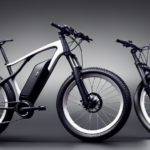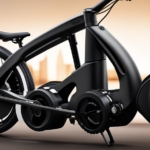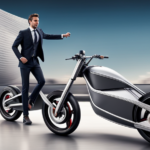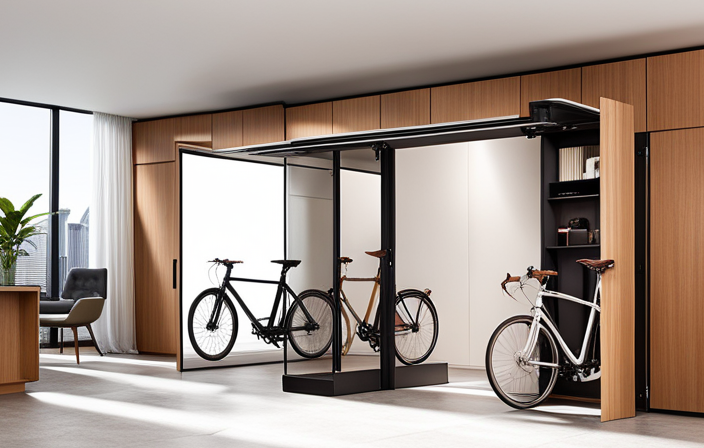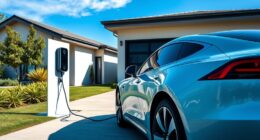Are you ready to take your electric bike riding experience to the next level? Get ready to be blown away by the incredible capabilities of a cadence sensor!
This small device may seem unassuming, but it has the power to revolutionize your cycling journey. With its ability to track your pedaling speed and rhythm, a cadence sensor ensures optimal efficiency and performance.
In this article, we will delve into the world of cadence sensors, exploring how they work, the benefits they offer, and how to choose the perfect one for your electric bike.
Get ready to pedal like never before!
Key Takeaways
- Consistent and efficient pedaling rhythm
- Improved performance and reduced fatigue
- Enhanced efficiency and precise training data
- Optimized riding experience and improved cycling
Understanding Electric Bike Components
The cadence sensor helps monitor the rider’s pedaling speed on an electric bike. It is a crucial component that provides valuable information to the electric motor. Understanding motor power is essential in maximizing the performance of an electric bike.
The cadence sensor measures the number of pedal rotations per minute (RPM) and relays this information to the motor controller, which then adjusts the power output accordingly. This ensures that the rider is always in sync with the electric assistance provided by the bike.
Additionally, choosing the right battery is crucial for optimizing the overall performance of the electric bike. A battery with sufficient capacity and voltage can provide the necessary power to the motor, allowing for longer rides and improved efficiency.
The role of sensors in electric bikes goes beyond just monitoring pedaling speed; they work together to provide a smooth and efficient riding experience.
The Role of Sensors in Electric Bikes
To understand how your e-bike functions, it’s important to recognize the significance of the sensors it relies on. These electric bike sensor types play a crucial role in determining the overall performance of your electric bike.
Here are four key ways in which sensors impact the performance of your electric bike:
-
Speed sensors: These sensors measure the speed at which your electric bike is moving, allowing the motor to adjust power output accordingly.
-
Torque sensors: By measuring the amount of force applied to the pedals, torque sensors provide a seamless and natural riding experience by adjusting the motor assistance accordingly.
-
Pedal assist sensors: These sensors detect the pressure and frequency of your pedaling, enabling the electric motor to provide the appropriate level of assistance.
-
Cadence sensors: Cadence sensors track the rate at which you pedal, helping the motor deliver power in sync with your pedaling cadence.
Understanding these electric bike sensor types and their impact on performance sets the stage for an introduction to cadence sensors.
Introduction to Cadence Sensors
Let’s dive into what cadence sensors bring to the table when it comes to enhancing your riding experience.
Cadence sensors are an integral part of electric bikes, as they provide valuable information about your pedaling rate. The introduction to cadence sensor calibration is crucial for accurate data tracking.
By measuring the number of pedal rotations per minute, cadence sensors allow you to gauge your pedaling efficiency and maintain a consistent rhythm. This information is especially beneficial for fitness tracking, as it helps you monitor your performance and set goals.
A cadence sensor enables you to track your progress over time and optimize your training sessions.
Now, let’s explore how cadence sensors work and how they contribute to a more efficient electric bike ride.
How Cadence Sensors Work
Cadence sensors work by measuring the rotation of your pedals, providing valuable data on your pedaling rate. These sensors are typically attached to the crank arm of your electric bike, using magnets and a sensor to detect each pedal revolution.
As you pedal, the sensor sends signals to a computer or display unit, which then calculates your cadence, or pedaling speed. By monitoring your cadence, you can improve your pedaling technique and optimize your power output.
A cadence sensor can help you maintain a consistent pedaling rhythm, which is key for efficient cycling. It can also help you identify any imbalances in your pedaling stroke and work on correcting them. With this information, you can then adjust your gear selection and pedal harder or softer to maintain your desired cadence.
This ultimately leads to a more efficient and enjoyable electric biking experience. So, let’s dive into the benefits of using a cadence sensor.
Benefits of Using a Cadence Sensor
One of the advantages of using a cadence sensor is that it helps you improve your cycling efficiency by providing valuable data on your pedaling rate. With this information, you can optimize your cycling performance by improving your pedal efficiency.
Here are five benefits of using a cadence sensor:
-
Real-time feedback: A cadence sensor gives you instant feedback on your pedaling rate, allowing you to make adjustments and maintain an optimal cadence.
-
Training tool: By tracking your cadence over time, you can identify patterns and trends, helping you tailor your training sessions to improve your pedal efficiency.
-
Prevents overexertion: A cadence sensor helps you avoid pushing too hard or spinning too fast, preventing muscle fatigue and reducing the risk of injury.
-
Enhances endurance: Maintaining a consistent cadence can help you conserve energy and increase your endurance during long rides.
-
Personalized workouts: With the data from a cadence sensor, you can create customized workouts that focus on improving specific aspects of your pedal efficiency.
By improving pedal efficiency with cadence sensors, you can enhance your cycling performance and achieve your fitness goals more effectively.
Improving Pedal Efficiency with Cadence Sensors
To improve your pedal efficiency, it’s important to focus on maintaining a consistent and optimal pedaling rate using a cadence sensor. This sensor measures the revolutions per minute (RPM) of your pedals and provides real-time feedback on your cadence.
By keeping your cadence within the recommended range, typically between 70 and 90 RPM, you can maximize your performance and minimize strain on your muscles. A higher cadence allows for smoother and more efficient power delivery, reducing the risk of fatigue and improving overall endurance.
With a cadence sensor, you can easily track your pedaling rate and make adjustments as needed, ensuring that you are getting the most out of your electric bike.
Transitioning into the subsequent section about ‘cadence sensor vs. torque sensor: what’s the difference?’, it’s important to understand the distinctions between these two types of sensors.
Cadence Sensor vs. Torque Sensor: What’s the Difference?
You can easily compare the differences between a cadence sensor and a torque sensor by understanding how they measure and provide feedback on your pedaling technique.
A cadence sensor measures the rotation of your pedals and provides information on your pedaling speed in revolutions per minute (RPM). It is a simple, yet effective tool that helps you maintain a consistent cadence, allowing you to pedal efficiently and reduce unnecessary strain on your muscles.
On the other hand, a torque sensor measures the force you apply to the pedals and provides feedback on how much power you are exerting. This sensor is more advanced and provides a more accurate representation of your effort and performance.
While both sensors have their benefits, a torque sensor offers the advantage of providing a more precise and responsive riding experience.
With this understanding, let’s move on to the next section about installing a cadence sensor on your electric bike.
Installing a Cadence Sensor on Your Electric Bike
Start by attaching the cadence sensor to the designated spot on your e-bike frame. The installation process is relatively straightforward and can be completed with a few basic tools. Once the sensor is securely in place, you can enjoy the benefits of using a cadence sensor on your electric bike.
A cadence sensor measures the rate at which you pedal and provides valuable information to enhance your cycling experience. It allows you to monitor your pedaling cadence, which is the number of revolutions your pedals make per minute. This information can help you maintain a consistent and efficient pedaling rhythm, leading to improved performance and reduced fatigue.
To help you visualize the importance of using a cadence sensor, here is a table outlining some key benefits:
| Benefits of Using a Cadence Sensor |
|---|
| Enhanced Performance |
| Reduced Fatigue |
| Improved Efficiency |
| Precise Training Data |
By installing a cadence sensor on your electric bike, you can optimize your riding experience and take your cycling to the next level. Now, let’s transition into the next section, where we will discuss troubleshooting common issues with cadence sensors.
Troubleshooting Common Issues with Cadence Sensors
Now that you’ve successfully installed a cadence sensor on your electric bike, let’s dive into troubleshooting common issues that may arise.
One of the most common problems is connectivity. If your cadence sensor isn’t connecting to your bike’s display or app, start by checking the battery level and ensuring your device is within range. If connectivity issues persist, try restarting both the sensor and your bike’s display.
Another issue you may encounter is inaccurate readings. To calibrate the cadence sensor for accuracy, make sure it’s positioned correctly on your bike’s crank arm and adjust the magnet alignment if necessary. Additionally, check for any interference from other electronic devices.
By troubleshooting these common issues, you can ensure that your cadence sensor functions optimally.
As we move forward, let’s explore how to customize the settings of your cadence sensor.
Customizing Cadence Sensor Settings
To customize the settings of your cadence sensor, simply access the menu on your device and adjust the preferences according to your personal biking needs. Customizing sensor settings allows you to optimize cadence performance and enhance your overall riding experience. The table below outlines the key settings that can be customized on most cadence sensors:
| Setting | Description | Range |
|---|---|---|
| Cadence Display | Specifies how the cadence data is displayed on the device | RPM, % of max |
| Cadence Threshold | Sets the minimum cadence value required for the sensor to register a pedaling revolution | 0 – 200 RPM |
| Auto Pause | Automatically pauses the cadence tracking when the bike is stationary | On, Off |
| Battery Saver Mode | Adjusts the sensor’s power-saving settings to prolong battery life | On, Off |
| Wheel Size | Allows you to input the circumference of your bike wheel for more accurate speed calculations | Varies by model |
By customizing these sensor settings, you can fine-tune your cadence tracking to suit your preferences and specific biking requirements. This will help you get the most out of your electric bike and improve your performance. Moving forward, you can integrate your cadence sensor data with e-bike apps to further enhance your riding experience.
Integrating Cadence Sensor Data with E-Bike Apps
Integrating cadence sensor data with e-bike apps enhances the riding experience and allows for a more personalized biking journey. By integrating cadence sensor data with fitness tracking, riders can monitor and track their cadence, which is the rate at which they pedal. This data can be used to optimize e-bike performance, as riders can adjust their pedaling speed to maintain a consistent cadence and maximize efficiency.
Additionally, integrating cadence sensor data with e-bike apps provides valuable insights into the rider’s performance, such as distance covered, calories burned, and average speed. This information can help riders set goals, track progress, and improve their overall fitness level. Furthermore, these apps often provide real-time feedback and coaching, helping riders maintain an optimal cadence for their specific goals.
Integrating cadence sensor data with e-bike apps truly revolutionizes the way riders interact with their electric bikes, making every ride more enjoyable and rewarding.
Moving on to cadence sensor maintenance and care tips…
Cadence Sensor Maintenance and Care Tips
Make sure you regularly clean and inspect your cadence sensor to ensure it is functioning properly. A well-maintained cadence sensor will provide accurate data and prolong its lifespan. To calibrate the cadence sensor, follow the manufacturer’s instructions and make adjustments as necessary. It is important to keep the sensor free from dirt, debris, and moisture, as these can affect its performance. Use a soft cloth or brush to gently remove any dirt or dust that may have accumulated on the sensor. Inspect the sensor for any signs of damage or wear, such as loose wires or cracks in the housing. If any issues are detected, contact the manufacturer for further assistance. By taking these maintenance and care tips into consideration, you can ensure that your cadence sensor performs optimally and lasts longer. And when you’re ready for enhanced performance, consider upgrading your cadence sensor for even better results.
Upgrading Your Cadence Sensor for Enhanced Performance
When you’re looking to improve your cycling experience, upgrading your cadence sensor can greatly enhance your performance. Upgrading cadence sensor technology offers a variety of benefits that can take your electric bike rides to the next level.
Here are four reasons why upgrading your cadence sensor is worth considering:
-
Improved accuracy: Advanced cadence sensors use more precise technology to provide accurate data, allowing you to track your pedaling rhythm with greater precision.
-
Enhanced connectivity: Upgraded cadence sensors often come with Bluetooth or ANT+ compatibility, allowing you to connect seamlessly with your smartphone or cycling computer for real-time data tracking.
-
Increased durability: Upgraded sensors are built with better materials and improved construction, ensuring they can withstand the rigors of intense cycling activities.
-
Advanced features: Upgrading your cadence sensor can unlock additional features such as power measurement, advanced training modes, and compatibility with third-party apps.
By upgrading your cadence sensor, you can maximize your cycling performance and explore advanced features that will further enhance your electric bike rides.
Exploring Advanced Features of Cadence Sensors
To fully optimize your cycling experience, you’ll want to dive into the advanced features that cadence sensors offer. These sensors not only track your pedal rotations per minute (RPM), but they also provide valuable insights to help you improve your cadence efficiency. By understanding your cadence patterns, you can make adjustments to your riding technique and gear selection to maximize your power output and endurance.
To further enhance your performance, it’s crucial to optimize the placement of your cadence sensor. Mounting it on the non-drive side crank arm is recommended for accurate readings. Additionally, ensure that the sensor is aligned properly with the magnet on the crank arm to avoid any interference or false readings.
Now that you are familiar with the advanced features of cadence sensors and how to optimize their placement, let’s explore the next step in enhancing your electric bike experience – choosing the right cadence sensor for your specific needs.
Choosing the Right Cadence Sensor for Your Electric Bike
Finding the perfect cadence sensor for your e-bike involves considering your specific requirements and preferences. When it comes to accuracy, it is essential to choose a cadence sensor that provides precise measurements. Look for sensors that have a high sampling rate and advanced algorithms to ensure accurate data.
Additionally, compatibility is crucial when selecting a cadence sensor. Make sure that the sensor you choose is compatible with your electric bike’s system. Some sensors are designed specifically for certain e-bike brands or models, so it’s important to check compatibility before making a purchase.
Consider whether you need a wireless or wired sensor, as well as the installation process. By carefully evaluating accuracy and compatibility, you can choose a cadence sensor that perfectly suits your electric bike and enhances your riding experience.
Frequently Asked Questions
Can a cadence sensor be used on a regular bike or is it only for electric bikes?
When it comes to using a cadence sensor on a regular bike, there are both pros and cons to consider.
One of the pros is that a cadence sensor can provide valuable data on your pedaling rhythm, helping you maintain an optimal cadence for efficiency and performance.
However, compared to cadence sensors for electric bikes, regular bike cadence sensors may not offer as many features or integration options.
It ultimately depends on your specific needs and preferences.
How does a cadence sensor measure the pedal rotations per minute (RPM)?
To measure pedal rotations per minute (rpm), a cadence sensor uses magnets and a sensor that attaches to the bike frame. As you pedal, the magnets on the crank arm pass by the sensor, creating a magnetic field that is detected. This data is then transmitted to a display or computer, which calculates your cadence.
Using a cadence sensor on an electric bike provides several benefits. It helps optimize your pedaling efficiency, allowing you to pedal at the most effective rate for your speed and terrain. This can help you conserve energy and avoid fatigue.
Additionally, a cadence sensor helps you maintain a consistent pace. By knowing your rpm, you can adjust your pedaling accordingly to stay at a desired speed. This is particularly useful during long rides or when riding in a group, as it helps you avoid sudden bursts of speed or slowing down unintentionally.
Furthermore, using a cadence sensor can improve your overall cycling performance. By tracking your cadence over time, you can set goals and monitor your progress. You can also use the data to analyze your performance and make adjustments to your training routine.
In conclusion, a cadence sensor is a valuable tool for electric bike riders. It provides important information about your pedaling rate, allowing you to optimize efficiency, maintain a consistent pace, and improve your overall cycling performance.
Can a cadence sensor be installed on any type of electric bike?
To install a cadence sensor on any type of electric bike, follow a simple installation process. Start by securing the sensor to the bike frame near the crank, ensuring correct alignment for accurate measurements.
Once installed, the cadence sensor provides numerous benefits. It measures pedal rotations per minute (rpm), allowing you to monitor your cycling efficiency. This data helps optimize your training, improve cadence, and achieve better overall performance on your electric bike.
Are there any limitations or compatibility issues when using a cadence sensor with certain e-bike models or brands?
When it comes to using cadence sensors on e-bikes, there can be limitations and compatibility issues with certain models and brands.
Different e-bike models may have specific requirements or restrictions when it comes to installing cadence sensors.
Additionally, not all brands of cadence sensors may be compatible with every e-bike brand.
It is important to do thorough research and consult the manufacturer’s guidelines to ensure compatibility and avoid any potential issues.
Can a cadence sensor be used in conjunction with other sensors, such as a torque sensor or speed sensor, for more accurate data collection?
To achieve advanced data analysis, you can use multiple sensors, including a cadence sensor, in conjunction with others like a torque sensor or speed sensor. This combination allows for more accurate data collection on electric bikes.
By comparing the accuracy of cadence sensors on different bike models, you can gain valuable insights into the performance and efficiency of each model. This information can help optimize the riding experience and make informed decisions when choosing an electric bike.
Conclusion
Congratulations! You now have a comprehensive understanding of what a cadence sensor does on an electric bike.
By monitoring your pedaling speed, this small but powerful device allows for a more efficient and enjoyable riding experience.
With its numerous benefits and easy maintenance, the cadence sensor proves to be an essential component for any electric bike enthusiast.
So, don’t hesitate to upgrade your sensor and explore its advanced features for enhanced performance.
Remember, choosing the right cadence sensor is like finding the perfect rhythm for your electric bike journey.
Happy riding!



